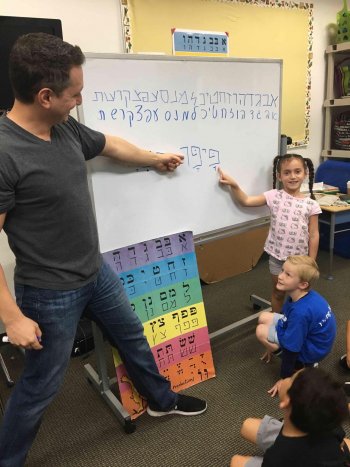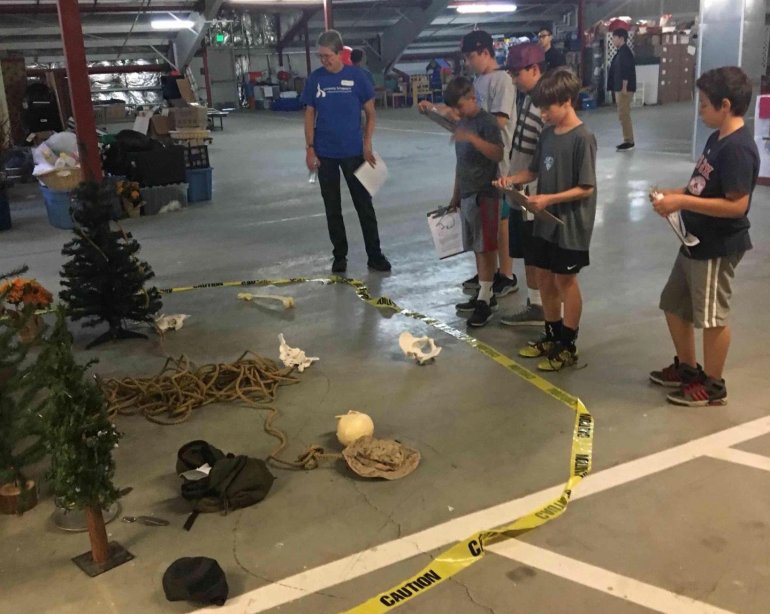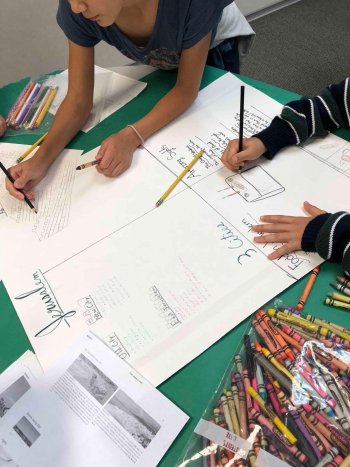Project-Based Learning: Living Judaism
University Synagogue, Irvine, CA
Not all models fit neatly into one of our major groups (or “buckets”). As new innovations emerge and new experiments are designed, we envision more models may cross-over or be outside of these buckets. In the future, we will most likely identify new groupings based on the success of these models.
Living Judaism is a Project-Based Learning model. Updated October, 2018.
Model Summary:
Living Judaism is an all-inclusive experiential learning model of Jewish Education. The purpose of the model is to engage every learner, provide carefully constructed learning experiences, build a strong identity, root students firmly in tradition, and create memories to last for years to come. University Synagogue’s hope is that their graduates will always see themselves as an integral part of the Jewish community, remembering the ritual, values, and warmth they experienced in Living Judaism.

The content that the children are learning is enhanced by incorporating a broad spectrum of activities using different ways of learning. Some of the experiences that are incorporated into the Living Judaism program include cooking, music, science, art, drama, games, technology, dance, debate, book club, Yiddish, Tikkun Olam, and Jewish values. Their Hebrew instruction takes place in multi-aged, tiny, fluid, ability-based groups. There is whole class instruction as well as one on one pull-out tutoring. This allows students to progress at their own pace. In addition to building reading fluency, Living Judaism also offers a conversational Hebrew component.
Sundays begin with Tefila services. Following Tefila, the younger students participate in a Yiddish Yeshiva program where they learn to use everyday Yiddish words and phrases, while the upper grades begin their class instruction. The students engage in a variety of activities to enhance their learning experiences. There is a large robust Madrichim and Junior Madrichim program for teens who assist in the classrooms. Project-based learning takes place in grade level classes around a curricular theme.

The educators personalize the Jewish learning experience for each of their students.
The program, which is customized to deliver a needs based education to everyone, reaches all types of learners. Teachers are licensed in special education, gifted education, occupational therapy, social work, psychology, science, art, technology, and Hebrew. Experienced classroom aides and shadows are provided to work with differently abled children. An on-site Inclusion Specialist works with the classroom teacher to modify and accommodate each child’s needs. Additionally, In-Home programing and Skype tutoring are offered for students who are unable to attend the regular program. The educator will customize Living Judaism’s education according to the individual learning style and the family’s needs.
Key First Steps and Recruitment Plan:
In order to keep up with emerging educational trends, University Synagogue decided to build an integrated, project-based, experiential learning model of Religious School. They are committed to positively engaging each learner. Their idea was to build a program that allowed every learner to achieve success and be engaged in a positive learning experience building identity and community. This model was launched at the start of the 2017-2018 school year.
The program was built using the Design Thinking model out of Stanford University and every aspect of it was "pretotyped" before being integrated into the model. All constituents were part of the pretotyping process including teachers, students, parents, board members, clergy, and administrative staff.

As the educator was visioning Living Judaism, she was thinking about the nature of the congregation; University Synagogue likes to be contemporary and likes to mix things up. There was a group of people who loved their previous model, Adventures in Jewish Education, and the experiential aspect of that model.
Key stakeholders were concerned about children sitting through another day and wondered: How can we “do Jewish” in a non-traditional method?
The educator noted that when she first began in her position, it was harder to sell a new model. The board now trusts her and respects her work.
Since the board had been part of the design process and had pretotyped various parts of the program, there were no surprises when the vote came to the board; the board unanimously approved the idea. University Synagogue began to build excitement for the program by previewing it on the last few days of Religious School the previous year. The first thing they noticed was how happy and engaged the students were. Parents began to spread the word and recruitment took care of itself through word of mouth. This innovation brought in a substantial amount of new students and families.
MODEL ELEMENTS
Who are the Learners?
Learners are Pre-K to 12th graders who are interested in pursuing a Jewish education. Grade level classes range in size from 12 to 20 students. A substantial number of the students come from interfaith families where one of their parents is Jewish; University Synagogue is a very inclusive, welcoming congregation.

Who are the Educators/Learning Facilitators?
The teachers include a variety of educational and educational service professionals as well as college students training to be in this field. They are chosen based upon their dedication to ensuring the success of each student and to providing a positive experience. They are creative, hands-on, engaged professionals who facilitate carefully designed experiential learning. Energy is a very important component in the hiring process. University Synagogue has a strong professional development program. Since it is integral to their congregation’s mission that their educators are part of the community, the teachers receive complimentary memberships.
Instructional aides, shadows and Madrachim are assigned to classrooms bringing the ratio of learner to teacher or other instructional aid is one to five.
What is the Learning? How is it Designed? What are the Learner Outcomes?
University Synagogue is committed to building strongly identified young people who actively participate in Jewish community well into adulthood. Their students come out of Living Judaism with a substantial knowledge of Jewish values, holidays, rituals, traditions, Torah, and Jewish foods; a love and understanding of Israel and the Middle East Conflict; and a strong group of Jewish friends. Although Hebrew is an integral part of our program, instruction is generally delivered in English.

Much of the learning is Project-Based Learning. For example, when learning about cities in Israel, students did online research in order to create videos and travel brochures for Israel. The students then presented these projects to the rest of the class. When students were learning about the Tower of Babel, groups were tasked with building a tower using upside-down cups. Before the task, each child was assigned one specific word, and that was the only word the child could say while figuring out how to build the tower with the group. After the activity, the students reflected on how easy or difficult it was to build this tower without a shared language.
Where Does the Learning Happen?
Learning happens in the classroom, Youth Group, Youth Band, at services, Shabbat dinners, workshops with our clergy, community wide Tikkun Olam projects, Young Cantors meetings, life cycle events, and everywhere their community comes together.
When Does the Learning Happen?
The Living Judaism program takes place on Sunday mornings from 9:00 a.m. to 12:00 p.m., throughout the week in the students’ homes through Skype, during Shabbat dinners and services, holiday programs and celebrations, and Youth Group events and get togethers.
Stories of Impact:
One of the students at University Synagogue was suffering with a devastating diagnosis. Her disease was not well known. Her classmates came up with the idea of setting up a non-profit organization to raise funds for research to find a cure and to bring awareness to the disease.
Setting up this non-profit became a class project, joining the group together in a shared mission while teaching all the power of making a difference.
Recently a set of twins became B’nai Mitzvah. The one brother read from the Torah, led the congregation in prayer, shared his D’var Torah, and chanted his Haftorah. His brother who is non-functioning autistic, celebrated becoming a Bar Mitzvah alongside him, participating to the best of his abilities. The inclusiveness of University Synagogue allowed everyone to celebrate both of the brothers.
University Synagogue is very proud that each Sunday there are 30-50 madrichim (teen teaching assistants) who come to help out with students at Living Judaism. It is thrilling that so many teens feel connected and choose to spend their Sunday mornings at the congregation.
ADMINISTRATIVE AREAS
Budget:
Teachers are compensated competitively according to their education and experience. Families pay:
-
$765.00 per child for the K-2 program
-
$1.040 for 3-7
-
$810 for 8th
-
$430 for Madrichim
-
At home, tutoring runs $1,250 for the first child and $750 for each subsequent family member.
Supplementary Materials Include:
How Do You Describe Your Congregation?
University Synagogue is a Reconstructionist Congregation. They serve approximately 635 households. They are a unique congregation with a high emphasis on education, social action, and intellectual engagement. There is a thriving adult education program which includes 35 classes, a leadership series, interfaith programming, and a speaker series. They also offer a cognitive impairment day-care program.

